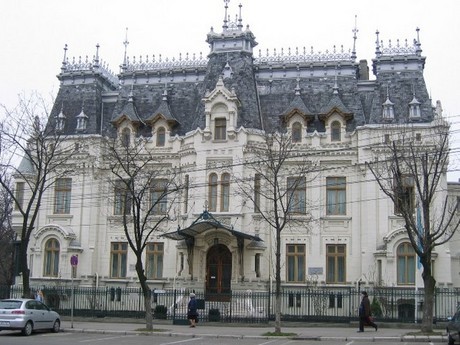Cantacuzino Palace
The palace was set in French Baroque style with Art Nouveau elements (1910), following Architect Berindei's plans. It was built by George Grigore Cantacuzino (1833-1913), also known as the Nabab – one of the richest men in Romania ever. After Grigore died, the building was inherited by his son, Mihai, once this one also died, by the latter's wife, Maruca. Maruca re-married in 1939, becoming the wife of George Enescu, Romania's greatest composer. Just before WW2, the building hosted the Council of Ministers. After the war, in 1956, it was turned into George Enescu Museum. The museum gathers documents and pictures referring to the composer’s life and work. Among other exhibits, there also is the violin the composer received as a present when he turned 4 year old.
On the first floor the balconies are guarded by great forged iron decorations, while the entrance is bordered by two lions. There are regular classical music concerts hosted by the palace (many of them being organized by the Polish Cultural Institute), and this is a good time to visit the building (for otherwise, the main hall of the palace is not included in the regular museum visit). The museum is open between 10.00 and 17.00, closed on Mondays.
Grigore Cantacuzino was thought to be one of Romania's wealthiest citizens in 1899. As Prime Minister, it was his wish to have the most elegant residence in Bucharest. Using the designs of architect Ion Berindei, the Cantacuzino Palace was built between 1898 and 1900 in eclectic French style. Combining a neoclassical architectural style with art nouveau elements, it features wrought iron balconies, tall arched windows and a porte-cochere (an elegant wrought-iron doorway) flanked by two lions. Today, the palace houses the George Enescu Museum.
Gheorghe Grigore Cantacuzino-"The Nabob" (1837-1913), a politician, former minister of finance, head of the Conservative Party, President of the Senate, Prime Minister, owner of a fabulous fortune, built the residence on Calea Victoriei in 1902, based on the plans designed by the architect I. D. Berindei. In 1913 „the Nabob” died and his elder son, Mihail (1864-1928), a famous politician himself, inherited the estate. Soon after his father’s death, Mihai Gh. Cantacuzino built the small pavilion behind the palace, as well as the dependencies which were absolutely necessary for a „hotel particulier”. In 1937, the edifice became residence of the great musician George Enescu. Between the years 1940-1941, the Cantacuzino Palace was, yet again, seat of the Ministries’ Council Presidency. In 1956 the National Museum “George Enescu” was established; in 1980 it became the Romanian Music Museum. In 1967, Maria Cantacuzino-Enescu (born Rosetti-Teţcanu), widow of George Enescu, donated the building to the Romanian State.
Due to its memorial value, as well as to its exceptional architectural quality, the edifice is included in most of the tourist guides, information brochures on the history of Bucharest, post cards or souvenirs. On occasion of the « International Festival and Competition George Enescu », the National Museum «George Enescu» is the host of many musical and cultural events. On special occasions, the establishment hosts music events, chamber music concerts, recitals of international artists.
Since 1956, the building has been the seat of the National Museum “George Enescu”- a famous personality of the national and universal classical music. The museum is open to the public and exhibits personal documents and objects which could speak of the artist’s personality. The museum hosts many cultural events relating to the world of music, book release festivities, conferences, high-life events or auditions. In order to rehabilitate the building and enhance its visibility, the Palace was one of the first monuments which were restored in Bucharest after 1989. It is included in the « Program for restoration of institutions located in buildings registered as historical monuments » of the Ministry of the Ministry of Culture and Religious Affairs, complete restoration works following to commence in 2007. A complex program for completing the museum-specific panelling inside the palace and in the adjacent areas.
The monument’ value is of universal recognition due to its memorial value as the last residence of the great artist George Enescu, a complex personality of universal music, a composer, violinist, pianist, conductor and professor, one of the most prominent musicians at the end of the 19th century and during the first half of the 20th century. The edifice was built on Calea Victoriei, one of the oldest streets of the city, by the Cantacuzino family- one of the most important European families of nobility with roots in France, Greece, Great Britain, Russia, the United States, Romania, which played an important role in the social, cultural and scientific life of those countries. It was used as head offices for the Government of Romania. From an architectural point of view, the edifice falls under the eclectic trend promoted by the Ecole des Beaux-Arts in Paris at the end of the 19th century, with art-nouveau elements, being designed by one of the first Romanian architects to ever study in Paris - I. D. Berindei. It was designed after the residences of the Parisian nobility of the “hotel particulier” type and it is regarded as top example of such an architectural type in Bucharest. It illustrates and contributes to the creation of Bucharest’s image as the « Little Paris ». From an engineering point of view, it was the first time in Romania to use heating system based on hot air circulated through pipes placed under the floors and in the walls. The public has always associated to the image of the renowned composer George Enescu, a most prominent personality who had a major contribution to the European music of the 20th century.




